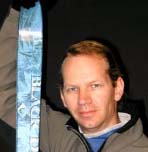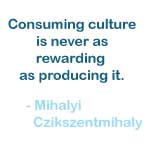
Wave Vidmar
1st American to attempt a solo unsupported
expedition to the North Pole

| |
|
Talk to Wave Live
Two lucky
classrooms will have an opportunity to talk with Wave live from
the North Pole via satellite phone!!!
Learn more |
|
 |
Purpose:
Students will
become information producers. They will increase skills in the
areas of thinking, imagining, visualizing, drawing, inventing,
and creating.
Discussion
Questions:
- What are some of the
challenges that you think Wave will face, as he travels solo
to the North Pole? How will creativity help him find
solutions?
- What kinds of things
limit or stifle creativity?
- What kinds of things
encourage and inspire creativity?
- Who are some of the
most creative people in the world today? Why?
- What is the difference between a consumer
of information and a producer of information?
- Describe your favorite ways to consume
information. (i.e. books, newspapers, TV, radio, movies,
dialogue with friends or family, etc.).
- Describe your favorite ways to produce
information (i.e. writing, drawing, designing, inventing,
taking photos, making videos, etc.)
- How important is it to you, to share what
you produce with others? Why or why not?
Suggested
Activities:
- Being creative is
seeing the same thing as everybody else, but thinking of
something different. Have students view the digital images
from the North Pole Solo expedition. (Or, have students cut
out interesting or unusual pictures from magazines). Then have
students think of clever or humorous captions for the photos.
Learn more
- Creativity is the
ability to generate novel and useful ideas and solutions to
everyday problems and challenges. Have students make a list of
North Pole Solo challenges. (Or, have students make a list of
ordinary annoyances, such as rush hour traffic, misplacing the
TV remote or keys, etc.). Then, have them brainstorm creative
solutions.
- Creativity is the action of
combining previously unconnected elements together. Divide
students into small groups. Ask each student to writing down
two nouns. Then, make a list of all the nouns and have the
students create a story from those words.
- An important rule for creativity is to suspend judgment,
by not criticizing your own ideas or the ideas of others. Have
students make a list of problems in their community (i.e.
trash on the beach, graffiti, homelessness, etc.) Then, ask
students to come up with solutions by answering "what if?"
questions. What if money was no object? What if we needed the
solution by tomorrow? What if we wanted to do the opposite?
- A variety of
popular imagery has been inspired by the Arctic regions,
ranging from Currier & Ives Prints to cigarette trading cards
to stereoscope and magic lantern views. Have students view
these images and discuss their significance.
Creativity
Resource Links
|